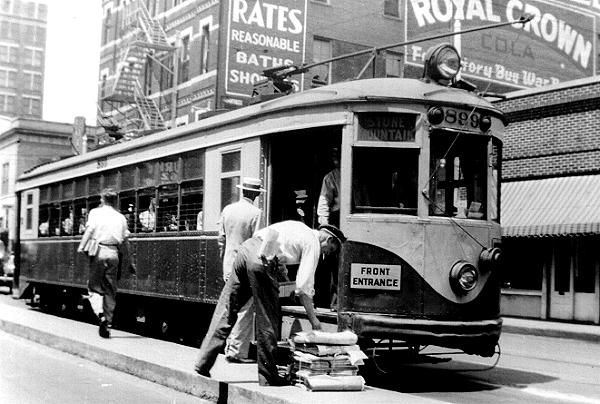
Sister car 899 in Atlanta in the late 1940’s – Bill Volkmer Collection at newdavesrailpix.com
- Builder
- Cincinnati Car Co.
- Description
- Lightweight
- Secondary Use
- Proposed restaurant
- Type
- City and Suburban Streetcars
- Year
- 1927
- Retired from Service
- 1968
- Acquired by the Museum
- 1988
- Note
- No. 876 is in Fairview carbarn. It is lettered “Bulldog Goldfield Railroad.”
- Fund
- 508
Georgia Power 876
From Atlanta, Georgia
History
Operating History: In 1927, Cincinnati Car Company built 40 cars (Nos. 860-899) for Georgia Power, which operated Atlanta’s streetcar system. These were lightweight cars similar to Cincinnati’s more distinctive curved side cars but with flat sides. Nos. 860-899 were the last of 243 similar, custom-designed cars purchased by Georgia Power in the 1920s. These were the last new streetcars purchased for Atlanta. Seating in Atlanta streetcars was racially segregated. The 860 series cars did not have a definite dividing line; Blacks would occupy seats from the rear forward and whites vice versa. The cars carried Georgia Power’s green and cream paint scheme used for one-man cars. Atlanta abandoned its streetcar system in 1949. In 2014, Atlanta opened a 2.7 mile modern streetcar line.
In 1950, during the Korean War, Korea Electric Company acquired 52 Atlanta cars for service in Seoul and Busan (previously known at Pusan). Cars going to Busan were mostly from the 860 series. The Atlanta cars replaced streetcars that had been damaged in the fighting. Korea Electric converted the cars to its 3’ 6” gauge and altered the front doors. Korea Electric renumbered the Busan cars into the 300 series, but Seashore has incomplete records to cross reference the Atlanta car numbers to the Korea car numbers. South Korea nationalized the Seoul and Busan systems in 1966. The former Atlanta cars ran until 1968.
Museum Ownership: As abandonment in Korea neared, Raoul Martin, owner of Seattle’s Northwest Shortline Model Works, was traveling regularly to Korea and arranged to have Busan car No. 352 saved and sent to the Puget Sound Railway Historical Society Museum in Snoqualmie, WA. However, the electrical equipment, including motors, was missing. The Snoqualmie museum, since named the Northwest Railway Museum, decided that transit equipment was not part of its collection focus. So, the car was sold for a planned spaghetti restaurant in Las Vegas, NV. The car received some restoration work, but the restaurant deal fell through. Two Las Vegas businessmen, Gianni Russo and Anthony Marnell, bought No. 352 and stored it at a Las Vegas contractor’s yard. Railfans saw the streetcar and persuaded the owners to donate the car to the Orange Empire Railway Museum in Perris, CA. The Orange Empire Railway Museum decided that its focus was on items related to California and that it only wanted No. 352’s narrow gauge trucks. So, a joint deal was arranged with Seashore.
In 1988, Orange Empire took the trucks from Las Vegas, and Seashore brought No. 352’s carbody to Maine and placed it on spare Laconia, standard gauge trucks. This was Seashore’s longest over the road move with its own personnel. Later, two Seashore members spent two weeks in Georgia inspecting nine disused Atlanta streetcar bodies and collecting parts for use in restoring Seashore’s car to its Atlanta appearance. Seashore could install suitable 177-E1X trucks either from Cleveland No. 1227 or City Lines of West Virginia No. 115. Seashore Historian, Ben Minnich, termed this car the most traveled tramcar in the world.
Initial inspection of pieces of No. 352 did not uncover the car’s original Atlanta number. The number might appear during more intensive restoration. Seashore’s curatorial file includes a handwritten list cross referencing some of the Atlanta and Korea car numbers, but not No. 352. Responding to a request for a car number from a possible donor, Seashore decided to identify the car as Georgia Power No. 876 from the car numbers not otherwise accounted for.
Technical Information
- Seats: 48
- Control: K-75
- Compressor: DH-16
Trucks
- Number: 2
- Manufacturer: Brill
- Model: Brill 177E-2X
Motor
- Number: 4
- Manufacturer: Westinghouse
- Model: 510C
Weight and Dimensions
- Length: 46’ 4.00"
- Width: 8’ 4.00"
- Height: 11’ 8.00"
- Weight: 37000 lbs.
© 1998 - 2025 New England Electric Railway Historical Society. All Rights Reserved.